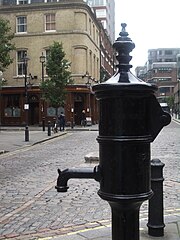John Snow (physician)
From Wikipedia, the free encyclopedia.
The English physician John Snow (March 15, 1813–June 16, 1858) was a leader in the adoption of anaesthesia and medical hygiene, and a pioneer of epidemiology.
Contents |
Education and training
The eldest son of a farmer, Snow was born in York where he studied until, aged 14, he was apprenticed to a surgeon, William Hardcastle, in Newcastle-on-Tyne. He later worked as a colliery surgeon. In October 1836 he enrolled as a student at the Hunterian school of medicine in Great Windmill Street, London; a year later, he began working at the Westminster Hospital, being admitted a member of the Royal College of Surgeons of England on 2 May 1838. He graduated from the University of London in December 1844, and was admitted to the Royal College of Physicians in 1850.
Anaesthesia
In 1846, Snow learned of the use of ether by American doctors as an anaesthetic. He developed new ways to administer the drug, demonstrating his techniques in the dental out-patient room at St George's Hospital. He was also well-versed in the administration of chloroform, a drug which he administered to Queen Victoria on 7 April 1853, during the birth of Prince Leopold, and again on 14 April 1857 at the birth of her youngest child, Princess Beatrice.
Cholera
Snow was a believer in the germ theory of cholera, as opposed to the then-dominant miasma theory. He first publicised his theory in an essay On the Mode of Communication of Cholera in 1849. In 1855 a second edition was published, with a much more elaborate investigation of the effect of the water-supply in the Soho, London epidemic of 1854.
By talking to local residents he identified the cause of the outbreak as the public water pump on Broad Street (now Broadwick Street), and it was disabled by removing the pump handle. Although this action has been popularly reported as ending the outbreak, the epidemic was already in rapid decline, as explained by Snow himself:
“There is no doubt that the mortality was much diminished, as I said before, by the flight of the population, which commenced soon after the outbreak; but the attacks had so far diminished before the use of the water was stopped, that it is impossible to decide whether the well still contained the cholera poison in an active state, or whether, from some cause, the water had become free from it.”
Snow later used a spot map to illustrate how cases of cholera were centred around the pump. He also made a solid use of statistics to illustrate the connection between the quality of the source of water and cholera cases. He showed that companies taking water from sewage-polluted sections of the Thames delivered water to homes with an increased incidents of cholera. Snow's study was a major event in the history of public health, and can be regarded as the founding event of the science of epidemiology.
In Snow's own words (in a letter to the Editor of the Medical Times and Gazette):
“On proceeding to the spot, I found that nearly all the deaths had taken place within a short distance of the [Broad Street] pump. There were only ten deaths in houses situated decidedly nearer to another street-pump. In five of these cases the families of the deceased persons informed me that they always sent to the pump in Broad Street, as they preferred the water to that of the pumps which were nearer. In three other cases, the deceased were children who went to school near the pump in Broad Street...
“With regard to the deaths occurring in the locality belonging to the pump, there were 61 instances in which I was informed that the deceased persons used to drink the pump water from Broad Street, either constantly or occasionally...
“The result of the inquiry, then, is, that there was been no particular outbreak or prevalence of cholera in this part of London except among the persons who were in the habit of drinking the water of the above-mentioned pump well.
“I had an interview with the Board of Guardians of St James's parish, on the evening of the 7th inst [Sept 7], and represented the above circumstances to them. In consequence of what I said, the handle of the pump was removed on the following day.”
Memorials
There is a plaque commemorating John Snow and his 1854 study in the place of the water pump on Broad Street (now Broadwick Street) with a water pump with its handle removed, near what is now the John Snow public house. The spot where the pump stood is covered with red granite. Snow died unmarried on 16 June 1858, and was buried in Brompton Cemetery.
John Snow was voted in a poll of British doctors in 2003 as the greatest physician of all time.
Snow gives his name to John Snow College, founded in 2001 on the University of Durham's Queen's Campus in Stockton-on-Tees.
Snow is one of the heraldic supporters of the Royal College of Anaesthetists.
References
- Peter Vinten-Johansen et al., Cholera, Chloroform, and the Science of Medicine: A Life of John Snow. OUP, 2003. ISBN 019513544X
- Edward Tufte, Visual Explanations, chapter 2. Graphics Press, 1997. ISBN 0961392126
- T. W. Körner, The Pleasures of Counting, chapter 1. CUP 1996. ISBN 0521568234
External links
- UCLA site devoted to the life of Dr. John Snow
- Myth and reality regarding the Broad Street pump
- John Snow Society
- Source for Snow's letter to the Editor of the Medical Times and Gazette
- beerintheevening.com - The John Snow Pub
- John Snow, Inc. Healthcare Consulting in the United States and around the world.




